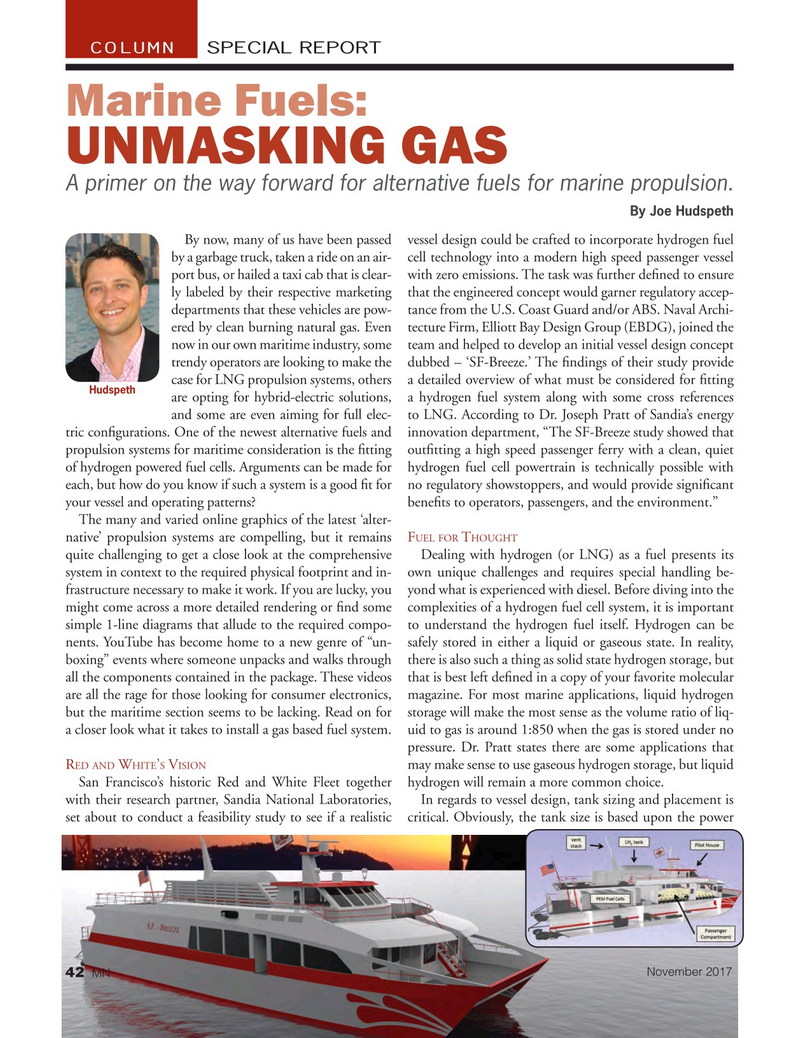
Page 42: of Marine News Magazine (November 2017)
Workboat Annual
Read this page in Pdf, Flash or Html5 edition of November 2017 Marine News Magazine
COLUMN SPECIAL REPORT
Marine Fuels:
UNMASKING GAS
A primer on the way forward for alternative fuels for marine propulsion.
By Joe Hudspeth
By now, many of us have been passed vessel design could be crafted to incorporate hydrogen fuel by a garbage truck, taken a ride on an air- cell technology into a modern high speed passenger vessel port bus, or hailed a taxi cab that is clear- with zero emissions. The task was further de? ned to ensure ly labeled by their respective marketing that the engineered concept would garner regulatory accep- departments that these vehicles are pow- tance from the U.S. Coast Guard and/or ABS. Naval Archi- ered by clean burning natural gas. Even tecture Firm, Elliott Bay Design Group (EBDG), joined the now in our own maritime industry, some team and helped to develop an initial vessel design concept trendy operators are looking to make the dubbed – ‘SF-Breeze.’ The ? ndings of their study provide case for LNG propulsion systems, others a detailed overview of what must be considered for ? tting
Hudspeth are opting for hybrid-electric solutions, a hydrogen fuel system along with some cross references and some are even aiming for full elec- to LNG. According to Dr. Joseph Pratt of Sandia’s energy tric con? gurations. One of the newest alternative fuels and innovation department, “The SF-Breeze study showed that propulsion systems for maritime consideration is the ? tting out? tting a high speed passenger ferry with a clean, quiet of hydrogen powered fuel cells. Arguments can be made for hydrogen fuel cell powertrain is technically possible with each, but how do you know if such a system is a good ? t for no regulatory showstoppers, and would provide signi? cant your vessel and operating patterns? bene? ts to operators, passengers, and the environment.”
The many and varied online graphics of the latest ‘alter-
UEL FOR HOUGHT native’ propulsion systems are compelling, but it remains F T quite challenging to get a close look at the comprehensive Dealing with hydrogen (or LNG) as a fuel presents its system in context to the required physical footprint and in- own unique challenges and requires special handling be- frastructure necessary to make it work. If you are lucky, you yond what is experienced with diesel. Before diving into the might come across a more detailed rendering or ? nd some complexities of a hydrogen fuel cell system, it is important simple 1-line diagrams that allude to the required compo- to understand the hydrogen fuel itself. Hydrogen can be nents. YouTube has become home to a new genre of “un- safely stored in either a liquid or gaseous state. In reality, boxing” events where someone unpacks and walks through there is also such a thing as solid state hydrogen storage, but all the components contained in the package. These videos that is best left de? ned in a copy of your favorite molecular are all the rage for those looking for consumer electronics, magazine. For most marine applications, liquid hydrogen but the maritime section seems to be lacking. Read on for storage will make the most sense as the volume ratio of liq- a closer look what it takes to install a gas based fuel system. uid to gas is around 1:850 when the gas is stored under no pressure. Dr. Pratt states there are some applications that
ED AND HITE S ISION
R W ’ V may make sense to use gaseous hydrogen storage, but liquid
San Francisco’s historic Red and White Fleet together hydrogen will remain a more common choice. with their research partner, Sandia National Laboratories, In regards to vessel design, tank sizing and placement is set about to conduct a feasibility study to see if a realistic critical. Obviously, the tank size is based upon the power
November 2017 42 MN

 41
41

 43
43
